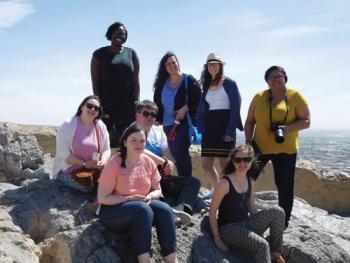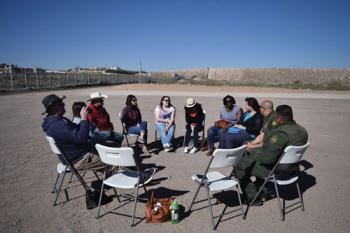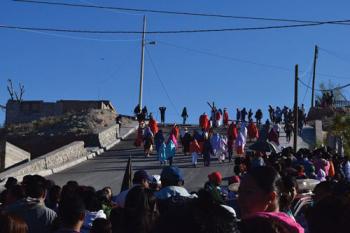 During Holy Week 2016, a mission exposure trip was organized by the Columban “Justice, Peace and Integrity of Creation” office in Britain. The participants spent Holy Week on the US/Mexican Border at El Paso, in Texas, United States, and at the city of Juarez, in the Mexican State of Chihuahua.
During Holy Week 2016, a mission exposure trip was organized by the Columban “Justice, Peace and Integrity of Creation” office in Britain. The participants spent Holy Week on the US/Mexican Border at El Paso, in Texas, United States, and at the city of Juarez, in the Mexican State of Chihuahua.
Activities were organized by the “Columban Mission Centre” in El Paso and the Columban parish of Corpus Christi in the suburb of Rancho Anapra, in Juarez.
Here is a sample of the reflections made by participants regarding different aspects of their experience.
Migrant Farm Workers in the El Paso area, Texas, United States
Venus Garcia-George is a youth worker based in London. She shares her experience of the plight of migrant farm workers. "On day four of our exposure visit, the harsh reality of the plight of migrant farm workers in Texas has hit hard. We visited the Sacred Heart Parish, where we had a talk from Carlos Marentes of ‘La Frontera (Frontier) Farmworkers Centre’. We then visited the ‘El Paso Diocesan Migrant and Refugee Service,’ at which we received a detailed and passionate presentation on immigrants’ rights from Carlos Marentes and Shalini Thomas. We later toured ‘the Annunciation House Refugee Shelter’.
"On day four of our exposure visit, the harsh reality of the plight of migrant farm workers in Texas has hit hard. We visited the Sacred Heart Parish, where we had a talk from Carlos Marentes of ‘La Frontera (Frontier) Farmworkers Centre’. We then visited the ‘El Paso Diocesan Migrant and Refugee Service,’ at which we received a detailed and passionate presentation on immigrants’ rights from Carlos Marentes and Shalini Thomas. We later toured ‘the Annunciation House Refugee Shelter’.
“Between July and November, thousands of workers from Mexico come looking for work. So what does a day in the life of a farmworker look like? It begins at two or three in the morning when recruitment of the workers takes place in South El Paso. Young labourers are hired first, leaving the older workers behind. The chili pickers leave for the fields at about 3:00am in the morning and start work at 6:00am. They then travel to the different farms, some of which are as far as Arizona. However the most popular ones are in New Mexico where chili peppers are a billion dollar industry. They finish around 4:00pm then return to El Paso and arrive around 6:00pm. It is a 16 hour long day.
“Chili pickers get paid piece rate for what they produce. For each bucket that is filled, the farm worker receives a plastic chip to be redeemed for payment at the end of the day. Each chip is worth US$65 cents, that is 65 cents a bucket.
“In order for a picker to make at least the minimum wage, they have to fill eight buckets. Each full bucket weighs around 18kg, which the workers carry on their backs to be unloaded every hour. By 3:00pm the chili picker is so tired from carrying these heavy buckets and from bending over to pick chilies from one metre high plants. Most pickers will pick an average of 30 buckets, which earns them a daily rate of US$19.50 even though in New Mexico the minimum hourly rate is US$7.25. The average annual income of chili pickers in the United States is US$6,700 yet a household of five in the United States is considered below the poverty line if their annual income is US$20,000.”
Border Control
Rosemary O’Leary is a teacher based in London. She shares her experience of a visit to Border Control.  "After a brief introduction by Columban Fr Robert Mosher of the ‘Columban Mission Centre”, we all piled into the van along with 11 fold-up chairs and off to the American Border Control we went. We were pleasantly greeted by two Border Control officers, Joe and Giovanni.
"After a brief introduction by Columban Fr Robert Mosher of the ‘Columban Mission Centre”, we all piled into the van along with 11 fold-up chairs and off to the American Border Control we went. We were pleasantly greeted by two Border Control officers, Joe and Giovanni.
“Open to the elements, we sat by the Anapra Fence with Mexico behind us. Joe and Giovanni talked to us about what their jobs entailed and what they experienced on a day to day basis, giving us some background to the ‘fence’s’ history and the experiences they have had during their time patrolling the fence.
“Before this talk, I had a very negative impression of the words ‘Border Control’ but their talks made me feel humbled by the sheer passion they have for both sides of the fence and the concern these officers have for the humanity they are trying to sustain on a daily basis.
“We later returned to the Columban Mission Centre to hear a talk by Molly Molloy, a Border and Latin American Specialist and the Librarian at the New Mexico University. She spoke about the fence that separates Mexico and the US and how different this fence is in different places.
“She also introduced us to the rate of crime that exists in Mexico, and how devastating it can be for the people living there, often facing desperate situations which may lead some Mexicans to venture over to the US illegally. This talk gave us a great insight into the gang culture and crimes that lead to someone wanting to risk their precious life to better themselves and their families.
“That evening we celebrated a bilingual Chrism Mass, in St Patrick’s Cathedral, El Paso, led by Bishop Mark Seitz and 70 priests.”
Immigration Court
Julia Corcoran is a Columban “Faith in Action volunteer” in Britain. She shares with us the experience of the Immigration Court.
"This morning we went to the Immigration Court. I was struck by how efficient the court is. Each case was brought forward to the judge and then the judge asked a few questions and a decision was made. None of the ten or so cases we saw today involved anyone being deported. At the same time our hour or so in court left me feeling emotionally drained. My degree and Masters is in Law and so I knew what to expect but I was still shocked at how the cases were decided. One of the attorneys on the phone was asked about the papers he had submitted and he admitted to not having the file in front of him. The judge seemed like an understanding but very busy judge. He even allowed us time to ask questions once all the cases had been seen. Today he will have seen 50 cases!”
Good Friday - The Way of the Cross
Mark Brown, a teacher from Dorset, England, shares his reflection of the Good Friday “Way of the Cross” liturgy at Corpus Christi Parish, Juarez, Mexico.
 The procession wound its way through the streets of Juarez and up Mount Anapra. It was led by American Columban Fr Robert Mosher from the Columban Mission Centre, El Paso, Australian Columban, Fr Kevin Mullins, the Parish Priest at Corpus Christi and Fijian Columban Lay Missionary Sainiana Tamatawale.
The procession wound its way through the streets of Juarez and up Mount Anapra. It was led by American Columban Fr Robert Mosher from the Columban Mission Centre, El Paso, Australian Columban, Fr Kevin Mullins, the Parish Priest at Corpus Christi and Fijian Columban Lay Missionary Sainiana Tamatawale.
1. Jesus is condemned to death. For all those “undocumented” migrants. How often do we make accusations about immigrants that are totally without foundation!
2. Jesus takes up His cross. I thought of farm workers who rise each morning just after midnight, with little more than three hours sleep, to search for work to feed their family whom they rarely see.
3. Jesus falls the first time. All those who because of the colour of their skin or the place of their birth fall through the system and are treated as criminals when all they wish for is a safe life for themselves and their children.
4. Jesus meets His sorrowful mother. I thought of the mothers of Juarez, Mexico, who have seen their sons murdered and their bodies left on the street.
5. Simon of Cyrene helps Jesus carry the cross. I prayed for the wonderful Columban missionaries, Fr Kevin and Sainiana, who walk alongside their parishioners in Anapra, risking their own lives to walk with the poor and oppressed.
6. Veronica wipes the face of Jesus. We saw the face of Jesus in so many members of the parish community.
7. Jesus falls a second time. For all those who find themselves in court, confused by the language of the state. Unable to afford decent representation and so place their future in the hands of ill prepared attorneys and translators.
8. Jesus meets the women of Jerusalem. Ruben Garcia from Annunciation House in El Paso, reminded us that simply feeling sorry for the poor is not enough. They do not need our tears but for us to change our behaviour.
9. Jesus fall the third time. That I may stop being part of the problem, destroying God’s beautiful world and begin to think more ethically about how I live and how I use the world’s resources.
10. Jesus is stripped of His garments. The factory workers in Juarez are denied basic rights and live on a wage far below the poverty line in order for us in the west to be able to buy cheap products.
11. Jesus is nailed to the cross. For those who flee dangerous homelands and come to the wealthy west seeking safety and sanctuary but instead find their family separated and are detained in detention centres.
12. Jesus dies on the cross. For all those men and women who have disappeared over recent years. For all the children who were taken from their families to be used for organ “donation”. For Rosa from Corpus Christi parish, whose brother and sister were murdered because they saw too much. For all those who refuse to pay “safety money” to the gangs.
13. Jesus is taken down from the cross. Annunciation House and those who offer free legal advice to the undocumented. For the Columban Missionaries in El Paso and all those who care for those who feel nobody cares and educate us that we might do better.
14. Jesus is laid in the tomb. That I might not be a secret witness to Christ like Joseph of Arimathea, afraid to share my faith.
Easter Vigil
Nathalie Marytsch is a Columban Lay Missionary from Chile working in Birmingham, England. She shares with us her experience of the Easter Vigil in the Cristo Rey community of the Corpus Christi parish, Juarez, Mexico
 "In the early evening we crossed the border to Mexico to celebrate the Easter Vigil with the Cristo Rey community. It was one of the most amazing celebrations I have been part of. A large crowd processed behind the Paschal Candle. The congregation of 400 people was comprised of many children, elderly folks and some street dogs, which the liturgy leaders tried very hard to keep out. There was also a talented group of about twenty musicians.
"In the early evening we crossed the border to Mexico to celebrate the Easter Vigil with the Cristo Rey community. It was one of the most amazing celebrations I have been part of. A large crowd processed behind the Paschal Candle. The congregation of 400 people was comprised of many children, elderly folks and some street dogs, which the liturgy leaders tried very hard to keep out. There was also a talented group of about twenty musicians.
“One of the most striking parts of the service for me was the blessing with the Holy Water. Columban Fr Kevin Mullins took time to go round each isle and corner of the church to bless the people, the candles and the water they had brought to be blessed. Fr Kevin took his time to greet people, with a kind smile and words of encouragement.
“I somehow felt that this is how I picture Jesus went around the crowds of people who were coming to listen to him. It was far from a quiet ceremonial ritual. There was a profound sense that it was a joyful occasion, the celebration of the resurrection of Our Lord and every part of the Mass had its sense of joy.”